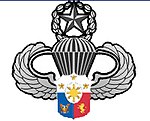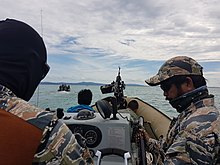Naval Special Operations Command
| Naval Special Operations Command (NAVSOCOM) | |
|---|---|
 NAVSOCOM Insignia | |
| Active | November 5, 1956 - Present |
| Country | Philippines |
| Branch | Philippine Navy |
| Type | Special Forces |
| Role | Special operations Direct action Counter-terrorism Special reconnaissance Unconventional warfare Hostage rescue Foreign internal defense Counter-proliferation Counter narcotic operations High value target raids Airborne operations |
| Garrison/HQ | Naval Base Heracleo Alano (Naval Base Cavite) |
| Nickname(s) | SWG, SWAG |
| Mascot(s) | Shark |
| Anniversaries | November 5 |
| Engagements |
Operation Enduring Freedom
War on ISIL
|
| Decorations | Presidential Streamer Award |
| Insignia | |
| Naval Parachutist Badge |  |
 | |
The Naval Special Operations Command (NAVSOCOM) formerly known as Naval Special Operations Group (NAVSOG) is a separate command of the Philippine Navy trained in special operations, sabotage, psychological and unconventional warfare and is heavily influenced by the United States Navy SEALs.
History[]
The predecessor unit to the NAVSOCOM, the Underwater Operations Team or UOT was activated on 5 November 1956 as a special operations unit of the Philippine Navy.[1] Patterned after the US Navy Underwater Demolition Teams and the Italian Decima Flottiglia MAS with modifications for Philippine conditions, from its founding the UOT was charged with conducting underwater operations in waterways, beach areas and harbors in support of Philippine naval operations. These operations included underwater explosive disposal, mine countermeasures, salvage and search and rescue. In 1959, the UOT was expanded and redesignated the Underwater Operations Unit (UOU), then as the Underwater Operations Group (UOG).[2]
The UOG was then renamed Special Warfare Group (SWG), then Naval Special Warfare Group (NSWG), and later on as the Naval Special Operations Group (NAVSOG). The unit's tasks were also expanded to cover all facets of unconventional warfare in a maritime and riverine environment. This includes but is not limited to demolition, hostage rescue, harassment, force protection and maritime tactical operations. The unit changed their name from NSWG to NAVSOG on May 30, 2005[3] before being renamed as NAVSOCOM.
NAVSOCOM is headquartered at Sangley Point, Cavite City. It has eleven units located across the Philippines, from Naval Operating Base San Vicente at Santa Ana, Cagayan in the north to Naval Station Zamboanga in the south. Each unit is attached either to a task force or a naval force and has a complement that varies from 3 to 6 SEAL Teams, with each team consisting of an officer and seven enlisted men. All team members "…are trained tactical divers, parachutists and demolitionists and in the execution of Special Warfare Operations from the Sea, Air and Land.” To become a qualified Philippine Navy SEAL, officers and enlisted men must successfully complete the six-month Basic Naval Special Warfare/SEAL Course.[4]
Role[]
The unit specializes in SEa, Air, Land (SEAL) operations ranging from reconnaissance, close combat, demolition, intelligence and underwater operations in support of overall naval operations. The unit gained prominence in a number of counter-terrorism operations, most notably against the Abu Sayyaf Group, and is known for its highly-demanding physical training program which is based on the United States Navy SEAL program.[5]
Training[]
The NAVSOCOM training program is known as Basic Naval Special Operations Course (BNSOC). The program is physically and mentally demanding and is regarded as one of the toughest military selection programs around the world. Candidates have to swim 3 kilometers and run 10 kilometers every day. Furthermore, they must swim 14.6 nautical miles from Roxas Boulevard in Manila to Sangley Point, Cavite City without any rest. They also undergo "Hell Week", considered as the most demanding week of BNSOC training. Candidates have to carry out demanding physical team events with their boat crews without any sleep at all for an entire week. In one BNSOC class, only 21 students remained from 79 applicants who originally started the BNSOC training program. These are only the common and basic training phases of BNSOC, with further evolutions of the training (including interrogation resistance) remaining highly classified.
Under Filipino law, women can apply to become SEALs, but thus far none have. Prospective SEALS are put through BUD/S, which lasts for four months and can often stretch into six with breaks between phases.[6]
United States influence[]
There are similarities between the Philippine Naval Special Warfare Group and the U.S. Naval Special Warfare Command. NAVSOCOM operators are trained and operate in a manner similar to the U.S. Navy SEALs. They also wear a trident similar to their U.S. Navy counterparts.

The Filipino counterpart of the U.S. counterterrorist United States Naval Special Warfare Development Group (DEVGRU) is the Philippine Naval Special Reaction Group (SRG), which operates under the direction of Naval Intelligence.[7]


They frequently train with their American counterparts and operate alongside the Philippine Marines and the Philippine Army's Special Operations Command (SOCOM).[8][9]
Units[]
NAVSOCOM is composed of the following units as of 2014:[10]
Base Units[]
- Headquarters, NAVSOCOM
- SEAL Unit
- Diving Unit
- Explosive & Ordnance Disposal Unit
- Special Boat Unit
- Combat Service Support Unit
- Naval Special Operations Squadron
[]
Each unit is made up of 3 to 6 special operations and support teams, each of which have 8 sailors (1 officer, 7 enlisted).
- Naval Special Operations Unit 1
- Naval Special Operations Unit 2
- Naval Special Operations Unit 3
- Naval Special Operations Unit 4
- Naval Special Operations Unit 5
- Naval Special Operations Unit 6
- Naval Special Operations Unit 7
- Naval Special Operations Unit 8
- Naval Special Operations Unit 9
- Naval Special Operations Unit 10
- Naval Special Operations Unit 11
References[]
- ^ "AFP chief vows more support for elite naval group". www.pna.gov.ph.
- ^ Military balance : the annual assessment of global military capabilities and defence economics 2017. Arundel House, Temple Place, London, UK: Routledge, Taylor & Francis for The International Institute for Strategic Studies. 2017. ISBN 978-1857439007. OCLC 960838207.
- ^ https://web.archive.org/web/20140319103149/http://navsog.navy.mil.ph/aboutus.htm
- ^ "Too Tough for the Job (The Navy Seals and Admin Diving)" - Philippine Navy Digest[dead link]
- ^ Manalo, Eusaquito P. (2004). The Philippine Response to Terrorism: The Abu Sayyaf Group. Storming Media. ISBN 9781423521877.
- ^ "NAVSOG: The past, present, and future of the Philippine Navy SEALs". SOFREP. 18 May 2017.
- ^ "Special Warfare Group (SWAG)". ShadowSpear. 29 January 2009. Retrieved 11 May 2015.
- ^ "Smoking-cessation classes, counseling among options offered on U.S. bases in Pacific". Stars and Stripes. Retrieved 11 May 2015.
- ^ "CARAT 2004: Philippine and U.S. Forces Train to Fight Terrorism" - Asia-Pacific Defense Forum, Winter 2005
External links[]
| Wikimedia Commons has media related to Naval Special Operations Command. |
- Special forces of the Philippines
- Philippine Navy
- Military units and formations established in 1956
- 1956 establishments in the Philippines
- Counter-terrorist organizations